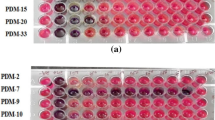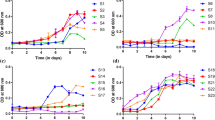Abstract
The present investigation was undertaken to degrade malathion from sugarcane contaminated agricultural soil using bacterial and fungal strains. Four bacterial and three fungal isolates were obtained by enrichment technique. Minimum inhibitory concentration was determined for these isolates; out of the four bacterial isolates, Achromobacter xylosoxidans JAS11 recorded the highest tolerance of 2,500 mg l−1 and degraded 1,000 mg l−1 of malathion, over a period of 5 days of incubation. Out of three fungal isolates, Aspergillus sp. showed tolerance limit of 800 mg l−1 of malathion and degraded 300 mg l−1 within 24 h of incubation. Apart from pesticide degradation, strain JAS11 was able to solubilize phosphates and make them readily available for plants and also had the ability to produce IAA.



Similar content being viewed by others
References
Abdel YM (2005) Molecular characterization of malathion biodegrading enzymes extracted from Egyptian bacterial isolates. New Egypt J Microbiol 10:226–231
Bhalerao TS, Puranik PR (2009) Microbial degradation of monocrotophos by Aspergillus oryzae. Int Biodeterior Biodegrad 63:503–508
Chatterjee S, Das SK, Chakravarty R, Chakrabarti A, Ghosh S, Guha AK (2010) Interaction of malathion, an organophosphorus pesticide with Rhizopus oryzae biomass. J Hazard Mater 174(1–3):47–53
Dastager SG, Deepa CK, Pandey A (2010) Isolation and characterization of novel plant growth promoting Micrococcus sp. NII-0909 and its interaction with cowpea. Plant Physiol Biochem 48:987–992
Goda SK, Elsayed IE, Khodair TA, El-Sayed W, Mohamed ME (2010) Screening for and isolation and identification of malathion-degrading bacteria: cloning and sequencing a gene that potentially encodes the malathion-degrading enzyme carboxylestrase in soil bacteria. Biodegradation 21:903–913
Hasan AH (1999) Fungal utilization of organophosphate pesticides and their degradation by Aspergillus flavus and A. sydowii in soil. Folia Microbiol 44:77–84
Hort JG, Krieg NR, Sneath PHA, Staley JT, Williams ST (1994) Bergey’s manual of determinative bacteriology, 9th edn. Williams & Wilkins Co., Baltimore
Kannan V, Vanita V (2005) Influence on assay medium on degradation of malathion by Serratia marcescens. Indian J Biotechnol 24:277–283
Kim YH, Ahn JY, Moon SH, Lee J (2005) Biodegradation and detoxification of organophosphate insecticide, malathion by Fusarium oxysporum f. sp. pisi cutinase. Chemosphere 60:1349–1355
Kumari B, Guha A, Pathak MG, Bora TC, Roy MK (1998) Experimental biofilm and its application in malathion degradation. Folia Microbiol 43(1):27–30
Mohamed ZK, Ahmed MA, Fetyan NA, Elnagdya SM (2010) Isolation and molecular characterisation of malathion-degrading bacterial strains from waste water in Egypt. J Adv Res 1:145–149
Mulla, Mian LS, Kawecki JA (1981) Distribution, transport, and fate of the insecticides malathion and parathion in the environment. Residue Rev 81:1–172
Nigg HN, Knaak JB (2000) Blood cholinesterases as human biomarkers of organophosphorus pesticide exposure. Rev Environ Contam Toxicol 163:29–111
Odenkirchen E, Wente SP (2007) Risks of malathion use to federally listed California red-legged frog (Rana aurora draytonii), pesticide effects determination. Environmental Protection Agency, Office of Pesticide Programs, Environmental Fate and Effects Division, U.S. Government Printing Office, Washington, DC
Pillans PIB, Steohenson A, Folb PI (1988) Cyclophosphamide effects on fetal mouse cephalic acetylcholinesterase. Arch Environ Contam Toxicol l62:230–231
Shimazu M, Mulchandani A, Chen W (2001) Simultaneous degradation of organophosphorus pesticides and p-nitrophenol by a genetically engineered Moraxella sp. with surface-expressed organophosphorus hydrolase. Biotechnol Bioeng 76:318–324
Singh B, Kaur J, Singh K (2012) Biodegradation of malathion by Brevibacillus sp. strain KB2 and Bacillus cereus strain PU. World J Microbiol Biotechnol 28:1133–1141
Tamer T, Medhat AH, EL-Naggar MA (2013) Malathion degradation by soil isolated bacteria and detection of degradation products by GC–MS. Int J Environ Sci 3(5):1467–1476
Uygun U, Ozkara R, Ozbey A, Koksel H (2007) Residue levels of malathion and fenitrothion and their metabolites in post harvest treated barley during storage and malting. Food Chem 100:1165–1169
Acknowledgment
Authors greatly acknowledge Department of Science and Technology (DST), New Delhi for providing the Grant (Grant No. DST/TSG/NTS/2009/67) for this research work.
Author information
Authors and Affiliations
Corresponding author
Rights and permissions
About this article
Cite this article
Abraham, J., Srujana, A. Microbial Utilization of Malathion Isolated from Contaminated Soil of Sugarcane Fields in Vellore. Agric Res 3, 339–345 (2014). https://doi.org/10.1007/s40003-014-0137-3
Received:
Accepted:
Published:
Issue Date:
DOI: https://doi.org/10.1007/s40003-014-0137-3




